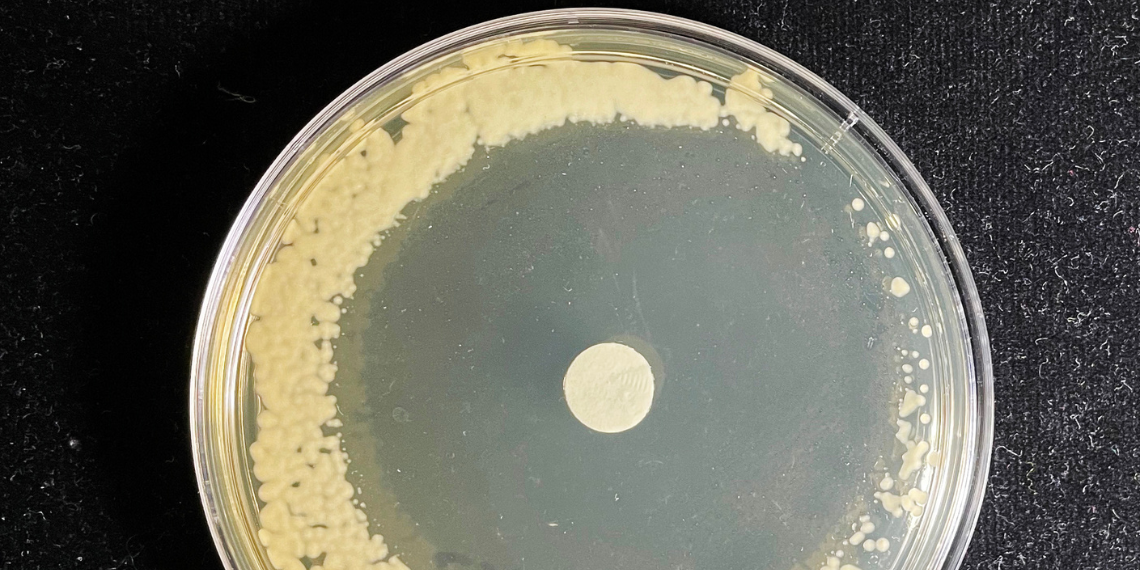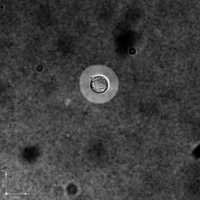New Study Adds to the Arsenal in the War on Fungal Pathogens

What do Superman, Achilles, and fungi all have in common? They all have a weakness, a kryptonite, an Achilles heel or, in the case of fungi, a druggable target.
Researchers from the Department of Molecular and Cellular Biology have identified a new therapeutic target for combating an important fungal pathogen, Cryptococcus neoformans. The target, identified by Dr. Jennifer Geddes-McAlister, Associate Professor and Canada Research Chair, and recent PhD grad Dr. Brianna Ball, is a previously uncharacterized protein that turns out to be vital to the fungus’s survival and its ability to cause disease.

Capsule production of Cryptococcus
neoformans H99 strain under iron
limited conditions by differential
interreference microscopy.
Cryptococcus neoformans is found throughout the environment in soil and decaying vegetation. Armed with elaborate adaptation mechanisms, this fungus has developed the ability to infect animals and humans, usually affecting the lungs and brain. About 230,000 people become infected annually, and those with weakened immune systems are particularly vulnerable.
“It's a fascinating pathogen with different challenges, because fungal cells are very similar to human cells. Dealing with them is tricky, as you don’t want to damage the host,” says Geddes-McAlister.
Geddes-McAlister, Ball and colleagues made the discovery as they sought to unravel the mystery of how C. neoformans can survive in harsh environments. The new protein – called Wos2 – is a key contributor to this process.
“We first identified Wos2 in a previous study, but it didn’t appear to have a large role. It wasn't our first choice to pursue further. It was Brie, the lead researcher on this study, who wanted to characterize this protein and solve this piece of the puzzle,” recounts Geddes-McAlister.
They were surprised to learn that Wos2 primarily functions in coordinating the fungus’ response to oxidative stress, which involves scavenging harmful unstable molecules that can damage the cell.
The researchers created genetic “knockout” strains of the fungus that don’t produce the Wos2 protein. These fungi showed decreased protection against oxidative stress and reduced growth under such conditions.
Taking their investigation one step further, the team exposed mice to these same knockout strains, and found that without Wos2, the resulting infection was much less severe.
The results confirmed the role of Wos2 in the fungus’ ability to cause infection by protecting it against the stress caused by the host’s immune response. It also means the protein represents a new potential anti-fungal drug target.
The Geddes-McAlister lab is one of only a few labs in the world to use mass spectrometry-based proteomics to study fungi. This approach looks at how protein production changes under different physical and biological conditions. It can also help identify potential drug targets by investigating the role of individual proteins that appear to be associated with key fungal processes, like infection of a host.

Melanin production by Cryptococcus
neoformans H99 strain.
“Wos2 presents a potential target and combining computational methods and screening libraries with proteomics, new drugs can be designed and their discovery accelerated,” says Geddes-McAlister.
The rise of anti-fungal resistance presents a new challenge to researchers and healthcare professionals, as current therapeutics become increasingly obsolete. There is a pressing need for new approaches that inhibit fungal infection strategies.
In addition to identifying a new anti-fungal target, these results will also impact other fungal researchers.
“It's a very collaborative community, where the results from one group can inform the research of another,” explains Geddes-McAlister. “Proteomics-based approaches offer a new technique for disease researchers to tackle rising anti-fungal resistance.”
This research highlights the importance of understanding fungal virulence and survival, and underscores the value of proteomics-based approaches.
“Don’t be afraid to pursue uncharacterized candidates,” advises Geddes-McAlister. “If we had stopped after the initial study, we would have missed all of this.”
Read the full study in the journal Microbiology Spectrum.
Read about other CBS Research Highlights.